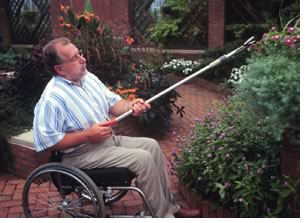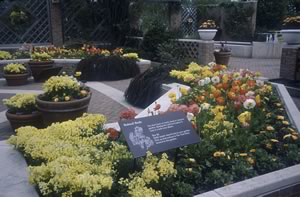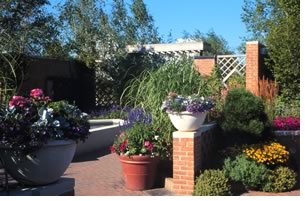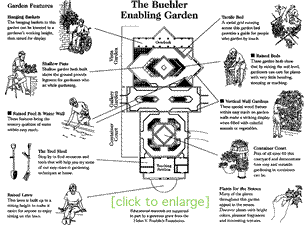

09/2004
For the many who visit the Chicago Botanic Garden, the 11,000-square-foot Beuhler Enabling Garden is their own piece of heaven in the luscious greenery. Desirous of a place to dig dirt or prune plants but unable to pursue traditional “hands and knees” gardening, they come to the Chicago garden to find the tools that can help them partake in a favorite activity at any age, ability, or stage of life.
 The
original Enabling Garden, built in 1976, had begun to show its age. In
the late 1990s a new chief executive and an updated master plan helped
bring the upgraded 11,000-square-foot resource to a more accessible spot
on the garden campus. Visitors to the site can now enjoy waterfall walls
and raised pools, paved walkways, and sweeping views of the garden campus.
Since its unveiling in 1999, the new Enabling Garden has become a model
for the design community, health and human service agencies, and home
gardeners.
The
original Enabling Garden, built in 1976, had begun to show its age. In
the late 1990s a new chief executive and an updated master plan helped
bring the upgraded 11,000-square-foot resource to a more accessible spot
on the garden campus. Visitors to the site can now enjoy waterfall walls
and raised pools, paved walkways, and sweeping views of the garden campus.
Since its unveiling in 1999, the new Enabling Garden has become a model
for the design community, health and human service agencies, and home
gardeners.
The design was the result of a collaborative process of garden staff, architects, landscape designers, experts on universal design, people with disabilities, and other related organizations such as the Smithsonian Institute, National Center on Accessibility, American Horticultural Therapy Association, and Chicago Mayor’s Office for People with Disabilities, explains Gene Rothert, manager of the Botanic Garden’s Horticultural Therapy services.
 The
garden is based on universal design principles. The basic materials correspond
with the surrounding gardens to ensure a consistent look throughout. Rothert
notes that it does cost more to create an Enabling Garden because of the
need for raised vertical beds which reduces growing space. The organization
saves money, though, with the assistance of volunteers and by planting
low-maintenance flora. Also, he notes, if the design is well executed,
the area can also serve as a venue for special events such as weddings
and garden parties to help justify the initial investment.
The
garden is based on universal design principles. The basic materials correspond
with the surrounding gardens to ensure a consistent look throughout. Rothert
notes that it does cost more to create an Enabling Garden because of the
need for raised vertical beds which reduces growing space. The organization
saves money, though, with the assistance of volunteers and by planting
low-maintenance flora. Also, he notes, if the design is well executed,
the area can also serve as a venue for special events such as weddings
and garden parties to help justify the initial investment.
Gardening for the soul
This activity-based gardening is being used in health-care settings as
a therapeutic tool, Rothert says. He says studies have shown that having
these spaces in hospitals hastens recovery time. In other facilities,
such as nursing homes, the gardens provide a sense of shelter and offer
opportunities for socialization and contact with nature. Rothert notes
that more work needs to be done to document the tangible benefits of enabling
gardens, which also can come under the heading of therapeutic, meditative,
and restorative landscape. The gardens can differ in size, scope, and
the degree to which participants interact with them.
 The
Enabling Garden offers classes and activities through the Chicago Botanic
Garden’s Horticultural Therapy Program. Each year, the horticultural
staff and volunteers plant 4,500 annuals to accent 365 perennials and
77 trees and shrubs. The area is designed as a formal garden with brick
and stone walls, trellised archways, and vaulted rooflines. Rothert says
that the features the gardens use most vary by season, but the water features
create particular interest as do the well-used sitting areas.
The
Enabling Garden offers classes and activities through the Chicago Botanic
Garden’s Horticultural Therapy Program. Each year, the horticultural
staff and volunteers plant 4,500 annuals to accent 365 perennials and
77 trees and shrubs. The area is designed as a formal garden with brick
and stone walls, trellised archways, and vaulted rooflines. Rothert says
that the features the gardens use most vary by season, but the water features
create particular interest as do the well-used sitting areas.
“Too many projects that have failed are ones that work backwards,” Rothert says. He suggests that it is important for architects to solicit information from professionals and people in the disability community and consider the range of disabling conditions that can reap therapeutic benefits.
 Rothert
and the Botanic Garden suggest the following tips for a successful enabling
garden.
Rothert
and the Botanic Garden suggest the following tips for a successful enabling
garden.
- Use tall containers to raise the soil level to a comfortable working height.
- Plant low-maintenance plants in hard-to-reach areas of your garden.
- Make sure your paving is level and firm to provide good traction at all times.
- Use soaker hoses for hard-to-reach areas of your garden. They conserve water and can remain in place the entire season.
- Plant dwarf or slow-growing trees and shrubs, which require less maintenance.
- Keep a few hand tools tucked away at various locations in the garden to save steps when retrieving tools.
- Use levers on gate latches, doors, and water facets. They are much easier to turn than round knobs.
- Use specially designed tools to garden in traditional ground-level beds with ease.
- Use vertical space with hanging baskets, trellises, and wall gardens to keep plants and vegetables within easy reach.
- Fill large containers and raised beds with easy-to-work soil made from equal parts (by volume) of topsoil, sand, and peat moss or compost.
Copyright 2004 The American Institute of Architects.
All rights reserved. Home Page ![]()
![]()
 |
||
| Images courtesy of the Chicago Botanic Garden. Visit the Chicago Botanic Garden Web site.
|
||